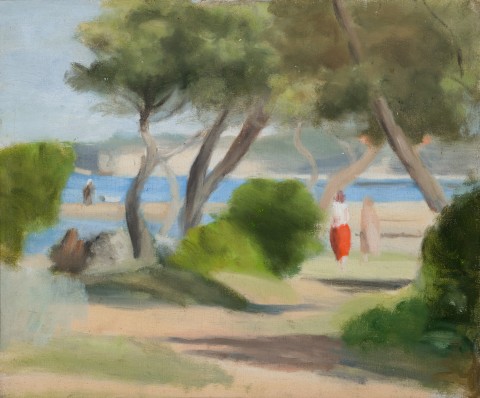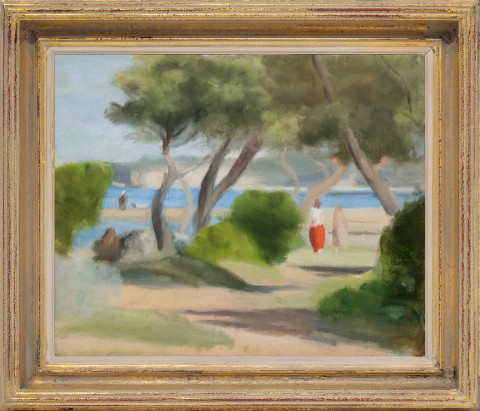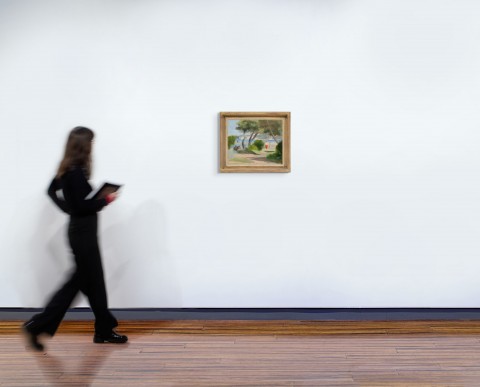FORESHORE AND FIGURES, c.1925
CLARICE BECKETT
also known as Ricketts Point
oil on canvas on board
37.0 x 45.0 cm
inscribed verso by Max Meldrum: B
Probably: Rosalind Humphries Galleries, Melbourne
Private collection, Melbourne
Leonard Joel, Melbourne, 12 April 1989, lot 189 (as ‘Ricketts Point’)
Private collection, Melbourne
We are grateful to Rosalind Hollinrake for her assistance with this catalogue entry.
Clarice Beckett is one of Australia’s most revered early modernists. After decades of neglect, her posthumous reputation has increased exponentially following a series of important retrospectives organised by Rosalind Hollinrake during the early 1970s, and despite no purchases of her paintings by any state gallery during Beckett’s short life, there is none that does not now proudly own examples of her work. Beckett’s images are immediately recognisable and are distinguished by the familiarity of the locations depicted – be it the city of Melbourne, the beach at Anglesea, the sun-drenched plains of the Western Districts, or, in the case of Foreshore and figures, the shoreline of Port Phillip Bay near the artist’s home in Dalgetty Street, Beaumaris. The freshness of Foreshore and figures is implicitly tied to its plein air execution, but the strength of its compositional design, colour and tonal accuracy is underpinned by Beckett’s continuous scrutiny of her neighbourhood.
Beckett’s skills as an artist were evident from an early age, however due to the intransigence of her domineering father, she was unable to commence any formal studies until she was twenty-seven. Starting at the National Gallery School in Melbourne, she subsequently undertook nine months of study in 1917 with the tonalist Max Meldrum, who taught his own theory known as the ‘Science of Appearances.’ Beckett’s colleague Colin Colahan edited a book on Meldrum’s lectures in 1919 with a key statement being that ‘tone and proportion gives us what is generally called ‘a perfect work of art’, without any relation to the actual amount of time which the Artist has bestowed upon his picture. Colour is the third and least important factor in depictive art.’1
Meldrum stressed the importance of close observation but also celebrated individual interpretation based on his teaching, and Beckett soon became one of his star pupils with Meldrum publicly noting that she was (almost) as good as him. This was faint praise as her combined talents also reveal a deep sense of poetry and Theosophical thought leading to her work that arguably surpasses that of her teacher. Beckett’s paintings sparkle with light and colour, and in 1930, she noted that ‘you always put a bit of the colour of the object you’re painting into its shadow, as it gives a greater luminosity’2, a technique clearly seen in Foreshore and figures, where the shadows of the ti-trees and shrubs contain tones of blue and apricot. There is an emphatic directness to the scene and crucially, the addition of the single patch of red for the woman’s dress provides a weighted visual counterpoint to the rest of the composition – indeed, it is as if the whole scene revolves around this one colour, a strategy that would have infuriated Meldrum. Defiantly her own artist, similar tactics may be observed in other key works by Beckett such as The red bus (private collection) and Walking home, c.1931 (Art Gallery of South Australia).
1. Meldrum, M., ‘The invariable truths of depictive art’, 1917, in Colahan, C. (ed.), Max Meldrum: his art and views, McCubbin, Melbourne, 1919, p. 43
2. Clarice Beckett, cited in Hollinrake, R., Clarice Beckett: the artist and her circle, Macmillan, Melbourne, 1979, p. 26
ANDREW GAYNOR


